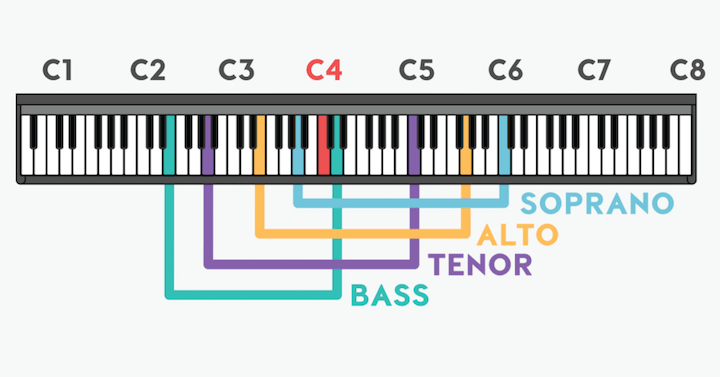Your Voices: Falsetto, Vocal Fry & A Vocal Range Chart
The human voice is simply amazing. It is the organ to the soul, as once mentioned by renowned British poet Henry Wadsworth Longfellow. And true enough, our voice is a powerful tool that we can use to convey our deepest emotions: happiness, sorrow, rage, fear, excitement and so much more.
But the human voice goes beyond that. It can be used to persuade, to inspire, to entertain, to make others feel different types of emotions, and yes, to make a living. We all know of ordinary individuals who rose to fame and became popular singers or speakers with the use of their voices.
Successful singers and effective speakers know that the human voice is very versatile. And, knowing how to “play the voice” using different techniques helped them to become popular. Let’s talk about the common vocal techniques that we hear in speaking and singing, and learn how these can also be beneficial to you.
Vocal Range Chart
Before we go into more detail about vocal techniques, it is important to find out your voice type first. The classification of voice types is actually based on many factors like gender, vocal weight and registration, vocal timbre, vocal quality, vocal tessitura and, of course, the vocal range. The vocal range is usually used as the main factor in classifying voices.
Simply put, the vocal range is the scale of notes, from the lowest to the highest, that an individual’s voice can produce. Here are the four major voice types:
Soprano
This is the highest female voice of all the vocal types. It is subdivided into the following categories which are more distinguished in classical singing: Lyric, Dramatic, Coloratura and Mezzo-Soprano.
Famous soprano singers for classical singing are the likes of Cecilia Bartoli, Faustina Bordoni and Monsterrat Caballé. For non-classical sopranos, we have popular names like Mariah Carey, Celine Dion, and Ariana Grande.
Alto
Alto, or contralto as it is known in classical singing, refers to the lower female voice. This is usually described as rich, “throaty” and resonant. Popular alto singers include Karen Carpenter, Alicia Keys, Tina Turner, and Shania Twain.
Tenor
The tenor is like the counterpart of the soprano in a male voice, but of course, in a lower voice range compared to that of a soprano. It is considered to be the highest range of voice in males. Similar to soprano, it is also subdivided into different categories which are: Lyric, Dramatic, Heroic and Tenor Robusto.
Popular tenor singers include the likes of Luciano Pavarotti, Freddie Mercury, Jon Bon Jovi and Phil Collins.
Bass
The bass is the lowest singing voice range for the male voice. Its name was derived from the Italian word basso which means low. There are also subdivisions for Bass which include Basso Cantante, Basso Buffo, Basso Cantante, and Basso Profondo. These subdivisions are more highlighted in classical singing.
Famous bass singers include Barry White, Peter Steele and Larry Graham. And, if you are aiming to have a rich bass voice, there are actually ways to make your voice sound deeper. Here’s a helpful article for you to read: How to Make Your Voice Deeper.
Identifying your vocal range is important because it will help you identify the correct type of songs or notes that you can sing comfortably and nicely. To identify your vocal range, the vocal range chart will come in handy. But first, check out the following short video and follow the guide to help you identify the lowest and highest notes that you can sing.
After identifying your lowest and highest notes, you may refer to the following voice range chart:

Voice Range Chart for Soprano, Alto, Tenor and Bass (Image Source: Vocalvigor)
- Soprano: A3 to C6
- Alto: E3 to G5
- Tenor: A2 to C5
- Bass: E2 to D4
Now, let us move on to discuss the terminologies that you will come across if you want to know more about vocal techniques. These are chest voice, head voice and falsetto.
Further Reading: Playlist Push Review + My Results
What Is Chest Voice?
A chest voice is that thick, warm and low tone that you produce when you sing or talk normally. It’s not produced in the chest, as we know that the voice is created by vibrations in the vocal folds which are amplified in the mouth and also in the pharynx. But it is called a chest voice because of the vibration that you also feel in your chest cavity while you are singing or talking.
The chest voice is usually used for singing in the lower pitch. It does not seem to be that hard, but it can’t be taken lightly. If you want to have a nice and warm chest voice while singing, and not put a strain on your voice, you need to have enough energy as well as a significant amount of airflow and power.
How to maximize/tap into your chest voice
The chest voice has a powerful quality to it and so the goal is to be able to use it at a higher range. In order to get the most out of your chest voice, you may do exercises that can widen your chest voice range.
You also need to keep in mind that it’s never good to “push” your chest voice into a higher range. Instead, you need to develop it gradually. Consistent practice, perseverance, and of course, patience will help you reach your goal.
Exercises to strengthen your chest voice
The chest voice needs a lot of air and support. And since it is produced within a muscle, it also needs to be strengthened and exercised. Check out these great exercises that can help improve the power of your chest voice:
What Is Head Voice
Head voice refers to the “upper register” or the voice that is produced when you go for higher notes. The vibration is usually felt in the head, hence the name. It is also usually not as powerful as the chest voice but is able to reach higher notes.
Often when your voice breaks – that is the break between your chest and head voice. Give it a try by making a siren sound. Start by making a very low sound – you should feel those vibrations down in your chest voice – and then raise the pitch of that sound – going from low to high. You’ll notice that tricky point in between where you seem to have to jump a bit and the vibration switches from being primarily felt in your chest to being felt in your head. That’s switching into head voice.
You can practice head voice in the same way you practice chest voice by running scales. The important thing to look out for is that you don’t constrict your vocal cords too much and choke off the sound and/or that you don’t make your voice to breathy and quiet way up there in your head voice.
Head Voice vs Falsetto
Falsetto has a hollow, airy and flutey quality. It is not as full as a head voice or a chest voice. It is usually used for effect, or to make a song sound more beautiful and dreamy. A singer can think of falsetto as a stylized head voice.
What Is Vocal Fry?
Whether it’s Britney Spears, Kim Kardashian, or Zooey Deschanel, you’ve probably heard your favorite pop singer or influencer make a croak-like sound at the end or beginning of their sentences. That creaky sound you hear that makes your ears tingle is called a vocal fry.
Celebrities are not the only ones employing this sound, though. This linguistic trend is sweeping the nation, especially among teens. It seems as if everyone is getting on the bandwagon.
But is doing a vocal fry a good thing? How does it affect your perception and the voice physically? Let’s find out more about the new ‘valleyspeak’ sweeping the world.
Is Vocal Fry Safe for Your Voice?
Vocal fry, also known as the creaky voice in linguistics, is the dropping of the voice to the lowest register possible. Doing this changes the vibration of someone’s vocal cords, creating an inconsistent pattern. This leads to the quiet, choppy sound that you hear when Kary Perry sings or talks.
The responses on the use of vocal fry are varied. Some think of it as a harmless trend that will soon pass, but others see the negative implications of using the technique. The boomers describe it as a debilitating “verbal tic of doom”.
A study done by Rindy Anderson and Casey Klofstad shows that those who employed vocal fry in the workplace were treated harshly and seen as less “hirable” by employers. Women were the most affected as they were seen as incompetent, uneducated, and unattractive compared to those that didn’t use vocal fry. Others have said the use of vocal fry among women makes them seem ”ditzy”.
An article written by Naomi Wolf goes a step further. She tells young women to rid themselves of this “heartbreaking trend” and encourages them to “reclaim your strong female voice.”
Men aren’t off the hook either. In a study done by Sarah Irons and Jessica Alexander, they observed it was males who often employed the use of vocal fry in daily life compared to their female counterparts.
But, there are some researchers that claim using vocal fry is advantageous to the user, especially if you are a woman. A 2010 study by Ikuko Yuasa argued that the use of a creaky voice is actually seen as a delicate and feminine trait, fondly associated with upwardly mobile women in America.
Also there is no denying that a technique that is sweeping pop culture is popular, and therefore helpful, in pop music. Brittney Spears really took vocal fry into the limelight with the heavy vocal fry opening line “Oh baby baby” in “Baby One More Time”
Is it safe to use vocal fry when singing or speaking?
Vocal fry will not affect your voice or vocal cords negatively as long as you feel relaxed while doing so. Applying the technique to your throat’s comfort level is the key to not damage your instrument.
There have been no significant studies that link vocal fry with voice damage. In the worst-case scenario, it can become a habit.
How Can You Achieve the Vocal Fry Sound?
If you want to achieve your voice’s full capacity, you need to learn different techniques to enhance it. One of these techniques is vocal fry.
It is quite easy to achieve.
Here are three easy steps to get a great vocal fry sound.
- Open wide and say “AHHHH” in your chest voice. Nothing fancy here–just use your speaking voice and tone to do this step.
- Next, slowly lower the pitch of your voice to the lowest pitch you can possibly do.
- You’ll slowly start to hear a faint croaking sound coming out of your mouth. This is a vocal fry!
Congratulations! You’ve unlocked a new technique perfect for singing rock songs or re-creating a bloodcurdling scream.
Remember to lower your voice to where you feel comfortable. If the pitch is not low enough, try doing this a few times a day to widen your vocal range. Your vocal cords will slowly get used to the exercise and you’ll be able to achieve the croak. It also helps to find your vocal range chart to assist you.
Exercises to Find Vocal Fry
If the steps above are not working out for you, there are other techniques and exercises to get that fried voice.
- Do it in the morning – Vocal coaches recommend trying to achieve the technique earlier in the morning. This is because our voices have not developed a lot of muscle tone yet. This helps create the sound easier.
- Even pulses – While lowering your voice to the lowest pitch possible, try to create an even vibration, also known as even pulses. This helps create a better-sounding fry.
- Reduce the air entering the larynx – While saying “AHHHH”, try to release the least amount of air as possible. The less air released, the more effective the next steps will be.
To deter the negative effects of doing vocal fry, make sure to only do the exercises in your comfort zone. The moment your throat starts to hurt, it may be a good idea to rest a bit and pick it up later.
Connecting All the Voices
Learning different techniques to enhance the voice is important to becoming a better singer or speaker. It helps you to become versatile and engaging. Most successful singers, are able to easily switch between the chest voice, head voice, falsetto, and throw in some vocal fry when they need some extra style. A variety in your voice also helps public speakers keep their audience engaged.
But trying to do these techniques without professional help can be risky for someone new to the singing world. If you plan to sing, even just casually, you should consider getting vocal or voice lessons. You can find more about learning how to sing here.
Doing different singing and speaking techniques should be both fun and safe!
Conclusion
Everyone has a different set of vocal cords that work differently. Some techniques may come easier for some people than others. What’s important is to remember that different voice techniques are advantageous for your growth as a singer and even as a speaker. To get started it is important to have a basic understanding of chest voice, head voice, falsetto, and vocal fry. Then to be aware of which voice you are using when speaking or singing.
What’s more with the voice is that the learning never stops. There’s always room for improvement and the more you can master singing or speaking in different genres and styles the better you’ll be able to deliver your songs and messages.









